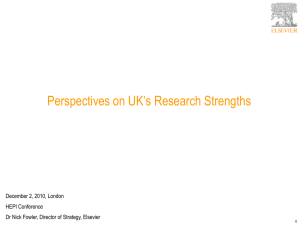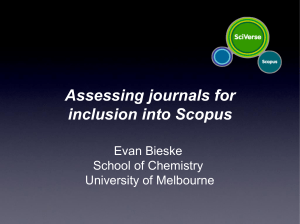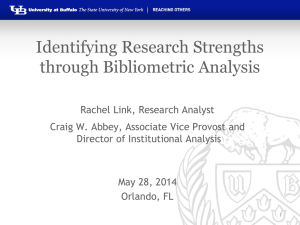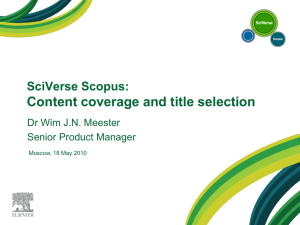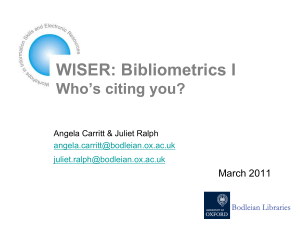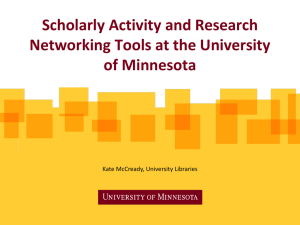what is spotlight
advertisement
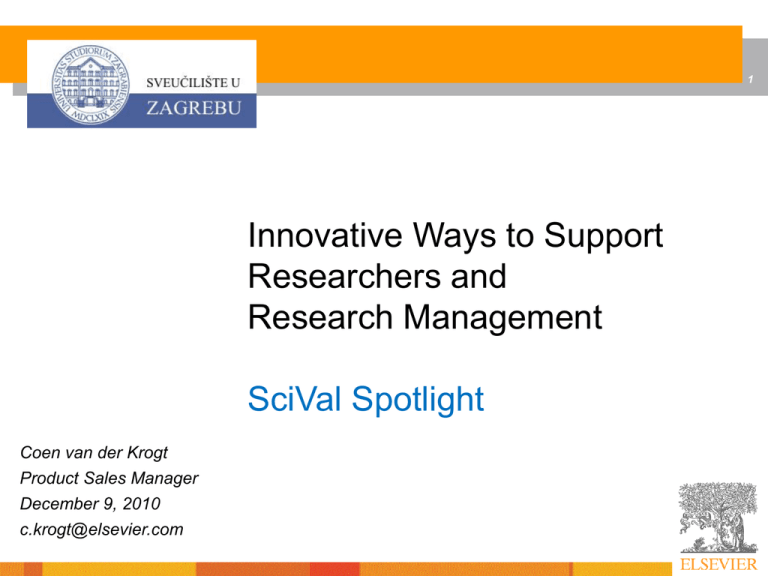
1 Innovative Ways to Support Researchers and Research Management SciVal Spotlight Coen van der Krogt Product Sales Manager December 9, 2010 c.krogt@elsevier.com Multiple Trends Impact The Research Landscape 2 High mobility Multidisciplinarity Research Strategy Improve research & outcomes Research Performance Competition / Collaboration Accountability / Government policies Agenda 3 Scopus Supporting Researchers Supporting Performance Evaluation Basis for analytical and workflow tools from the SciVal suite SciVal Spotlight Supporting Research Management Scopus - Most comprehensive Abstracts and Citations database 4 Secure institutional success . .. . . . thereby unlocking the library’s full potential enabled by . .. Improve productivity of Researcher and Student: • Most efficient and effective search • Access to most comprehensive content Increased prestige, ranking and funding because you . . . . . . and (c) provides access to the most comprehensive content . . . . . . (b) offers you the most efficient and effective search . . . . . . improve your institutional productivity . . . . . . by enabling the management to make better decisions . . . …because Scopus (a) enables you to evaluate performance and quality accurately . . . . . . and improving student and researcher productivity . . . Best evaluation of performance and quality: • Broadest coverage of peer-reviewed, high quality journals • Globally as well as locally • More accurate citation count, fairer recognition for work Scopus has significantly more journals in its database than WoS 5 WoS total: 11,419 Scopus total: 19,981 Unique WoS Joint titles: titles: 896 10,523 Unique Scopus titles: 9,458 Year 2010 Source: JISC Collections Academic Database Scopus has a large article coverage per subject area 6 Web of Science Scopus versus WoS content coverage (number of journals) Scopus Engineering & environmental Sciences Physical, Chemical and Earth Sciences 4000 6000 Mathematics, Information & Communication Sciences Biomedical & Clinical Research 2500 7000 1250 3500 0 0 3000 4000 2000 2000 1000 0 0 Humanities & creative arts Social, Behavioural & Economic Sciences 4000 Biological Sciences and Biotechnology Public and Health Services 2000 5000 1000 2500 2000 1500 0 0 0 0 3000 a perfect global coverage 7 Web of Science Scopus versus WoS geographical coverage (number of journals) Scopus 2,000 8,000 2,000 8,000 1,000 Less than 10% of our nearest competitor’s journals come from outside North America and Western Europe Scopus has more than 20% of its journals from outside this region 4,000 1,000 4,000 0 0 0 0 500 600 300 250 300 150 0 0 Scopus covers “local” content for local audiences and for audiences who want to know what is happening elsewhere 7 0 Example: higher coverage of local journals from Croatia in Scopus 8 78 active titles (total 104, including 26 inactive titles) January 2010 Figures Journal Evaluation – some challenges: 9 • I’m a publishing author in a niche area, how can I compare with researchers in another scientific field? • How can I get a value that reflects citation behaviour in my research area? • It’s 2010 – why can I only get a ranking relevant to 2008? • Where can I find the data that have been used to generate this number? • The Impact Factor does not cover the journal I’m publishing in. What now? Summary: Difficult to compare Not recent enough Lack of clarity of data origin Lack of coverage January 2010: 2 new journal metrics in Scopus - SJR and SNIP 10 SJR - SCImago Journal Rank SNIP - Source-Normalized Impact per Paper Comparison Recent Data origin Coverage Normalization of differences between fields Refreshed twice per year: April and September Eliminates risk of manipulation All 19,000+ journals, proceedings and book series in Scopus receive SJR and SNIP values www.journalmetrics.com Journal Analyzer in Scopus 11 The Research Landscape is changing 12 ...Elsevier Is Changing With You Solutions based on Scopus Supporting Research Management Positioning Overview: SciVal Suite Performance & Evaluation AGGREGATION Institution/Country BUYER USER CUSTOMER CHALLENGES PRIMARY Office of Research ADDRESSABLE VC/President PRIMARY Spotlight •What are my interdisciplinary strengths? •Who are the high performers in my strategic priorities? •How can I act upon my competitive advantage? Researcher/Group Strata Dean •Dean •Dept. Head •How are my researchers performing relative to their peers? •I want to evaluate researchers with the criteria that are important to me. Demonstration of Expertise Network Institution Showcase •VC/President •Library •Researchers •Students •I want to demonstrate my institution’s research expertise in the areas that are of strategic importance to us Research Support Researcher Expert Scopus- Profiling EP-VIVO •VC/President •Dir. Research Admin. •Dean •Researchers I need to find researchers in other disciplines that I can collaborate with in my institution (or within the EP community) Funding VC/President Dir. Research Admin. •Dir. Research Admin. •Researchers •Researchers •Research Admin Staff Dir. Research Administration: I need to easily populate VIVO with my researchers’ profiles Researchers: I need to find researchers from other institutions with whom I can collaborate •Find funding opportunities •Determine the right funding strategy •Increase success rates SciVerse Scopus Library •Researchers •What are the most highly-cited articles and authors within a research area? •h-index of an author •Overview of all of an author or institution’s publications 13 PRIMARY CUSTOMER GOAL(S) SUPPORTED BY THE SUITE 14 Determining research strategy at the level where it counts: the topics that researchers are focused on, not the fields they're in Spotlight Funding Strata Showcase Expert Profiling Reviewer Finder Scopus.com Identifying researchers with certain expertise for recruitment or collaboration Assessing productivity and impact of researchers and their output Demonstrating research excellence for the institution Finding grants that are matched to the right research topic or researcher 15 SciVal Spotlight WHAT IS SPOTLIGHT ? 16 1. Definition: • Spotlight is a web based solution to identify the institutional research strengths. With the aim to assess the institutional strategy of research management • It is NOT an evaluation tool for authors or papers 2. What we define as a research strength (competency)? • Areas of research (multi- or single-discipline) where our institution has a significant quantity of papers (from one or more authors) published during the last 5 years • So some highly cited authors may not be shown... WHAT IS SPOTLIGHT ? 17 3. How we define the areas of research? • Not by: disciplines, key words or journals. • By the CO-CITATION ANALYSIS and the yearly creation of the map of science (Klavans & Boyack). CO-CITATION ANALYSIS: BASED ON TWO ASSUMPTIONS 18 1 2 Paper Paper 1 2 Paper 1 Ref. Ref. Ref. Ref. Paper Paper Paper Paper A B A B Paper 3 Ref. Ref. Paper Paper A B Ref. Ref. Paper Paper A B A and B have a Strength of relationship proportional cognitive relationship to frequency of the co-citation linkage CO-CITATION ANALYSIS: BASED ON TWO ASSUMPTIONS 19 4. What is the base of co-citation analysis? • • • We group all the papers indexed in SCOPUS during the last 5 years in clusters (approx 90.000) based on their references. We select the clusters in which our institution has a significant number of papers (compared with the largest competitor world wide - RAS). We group the selected clusters in competencies based on the references of the papers published by our institution SAME CLUSTERS; DIFFERENT GROUPINGS = DISTINCTIVE COMPETENCIES Athena University’s map Einstein University’s map •DC 1 = clusters C, D & E •DC 1 = cluster A •EC 2 = cluster B •EC 2 = clusters B, C & D 20 SciVal Spotlight – Research Portfolio Analysis and Optimization 22 Identify Competencies and Market Strengths Attract Funding Spot Interdisciplinary Trends Strengthen Collaboration Improve Recruitment and Retention Use Funds More Strategically Insight in global strengths 23 COMPUTER SCIENCE MATHS & PHYSICS SOCIAL SCIENCE CHEMISTRY MULTI-DISCIPLINARY RESEARCH AREAS BRAIN RESEARCH ENGINEERING HEALTH SCIENCE EARTH SCIENCE RESEARCH AREA WITH GLOBAL STRENGTH (Competency) BIOLOGY MEDICINE 23 BIOTECHNOLOGY INFECTIOUS DISEASE Insight in global strengths 24 A larger circle means a larger market size (number of publications) for this Distinctive Competency MULTI-DISCIPLINARY RESEARCH AREAS Each circle represents a Distinctive/Emerging Competency for your institution Circles positioned towards the middle indicate an interdisciplinary mix 24 VISUALIZATION - MATRIX Question mark Star Dog Cash cow low high low Market Growth 25 Relative Market Share Matrix from the Boston Consulting Group 25 MATRIX VIEW: Distinctive competency performance relative to your largest competitor Find rapidly emerging areas of research; potential areas for further investment Select a view to see in which areas you are growing or reducing market share 27 The 2009 Spotlight map of University of Zagreb General Statistics 28 University of Zagreb 29 127 (low level) competencies University of Zagreb 30 12 high level competencies Clicking through from high level to low level competencies 31 Low level competencies within high level competency Medical Specialties 32 Clicking through to the details of DC1 33 Looking at the details of DC1 34 More details on DC1 35 What are the top authors in DC1? 36 Check the metrics for the most interesting authors What are the top authors in DC1 from University of Zagreb? 37 Click on an author, to get more details 38 What are the top authors in DC1 collaborating with University of Zagreb? 39 Combining ‘’All authors’’ with ‘’Collaborating authors’’ leads to new potential collaborators 40 What are the top institutions in DC1? 41 Check the metrics for the most interesting institutions What are the top institutions in DC1 collaborating with University of Zagreb? 42 Combining ‘’All institutions’’ with ‘’Collaborating institutions’’ leads to new potential collaborators 43 Overview of all competencies 44 Use Case Reaching and Maintaining Leadership 45 High Level Competency's map of 2009 46 Reaching and maintaining leadership 47 Reaching and maintaining leadership 48 Details of EC 18. Quality indicators 49 Institutions in EC18 50 Authors in EC18 51 52 53 54 Collaboration sheet – future functionality 55 SciVal Spotlight – Summary 56 Identify Competencies and Market Strengths Attract Funding Spot Interdisciplinary Trends Strengthen Collaboration Improve Recruitment and Retention Use Funds More Strategically 57 Thank you for your attention. Questions? Coen van der Krogt c.krogt@elsevier.com Tel: +31 6 3011 6125 58 Backup slides 59 1. Comparing different years? 2008 MAP 2009 60 Different position different multidisciplinary mix. Different position means different strategic market position. General Statistics 61 Comparing the years? 62 The reasons comparison of maps year-to-year has some limitations, is because the algorithm that drives Spotlight goes back to five years of prior articles as an analytic window. When a new year map is created, roughly 20% of the articles (i.e. from 2004) are dropped and a new full year of data (2009) is added. In future releases, we are committed to making it easier to compare maps year-to-year by introducing time-series analysis capabilities into Spotlight. 2. The 2009 Spotlight map of Ruder Boskovic Institute 63 Ruder Boskovic Institute 64 36 (low level) competencies 65 66
